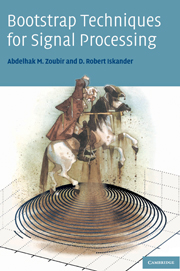
-
Select format
-
- Publisher:
- Cambridge University Press
- Publication date:
- 03 December 2009
- 06 May 2004
- ISBN:
- 9780511536717
- 9780521831277
- 9780521034050
- Dimensions:
- (247 x 174 mm)
- Weight & Pages:
- 0.625kg, 232 Pages
- Dimensions:
- (247 x 174 mm)
- Weight & Pages:
- 0.373kg, 232 Pages
You may already have access via personal or institutional login
Book description
The statistical bootstrap is one of the methods that can be used to calculate estimates of a certain number of unknown parameters of a random process or a signal observed in noise, based on a random sample. Such situations are common in signal processing and the bootstrap is especially useful when only a small sample is available or an analytical analysis is too cumbersome or even impossible. This book covers the foundations of the bootstrap, its properties, its strengths and its limitations. The authors focus on bootstrap signal detection in Gaussian and non-Gaussian interference as well as bootstrap model selection. The theory developed in the book is supported by a number of useful practical examples written in MATLAB. The book is aimed at graduate students and engineers, and includes applications to real-world problems in areas such as radar and sonar, biomedical engineering and automotive engineering.
Reviews
'… an excellent text for a graduate level engineering course or a useful reference for those who wish to apply bootstrap techniques in their work.'
Source: Annals of Biomedical Engineering
Contents
Metrics
Full text views
Full text views help Loading metrics...
Loading metrics...
* Views captured on Cambridge Core between #date#. This data will be updated every 24 hours.
Usage data cannot currently be displayed.
Accessibility standard: Unknown
Why this information is here
This section outlines the accessibility features of this content - including support for screen readers, full keyboard navigation and high-contrast display options. This may not be relevant for you.
Accessibility Information
Accessibility compliance for the PDF of this book is currently unknown and may be updated in the future.


